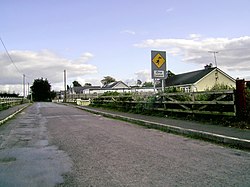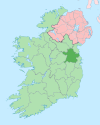Village and Gaeltacht in Leinster, Ireland
| Ráth Chairn Rathcairn | |
|---|---|
| Village and Gaeltacht | |
 | |
 | |
| Coordinates: 53°36′39″N 6°51′48″W / 53.6108°N 6.8632°W / 53.6108; -6.8632 | |
| Country | Ireland |
| Province | Leinster |
| County | County Meath |
| Elevation | 61 m (200 ft) |
| Population | |
| • Total | 447 |
| Irish Grid Reference | N800567 |
| As a Gaeltacht, Ráth Chairn is the sole official name | |
Ráth Chairn (anglicised as Rathcairn or Rathcarran) is a small village and Gaeltacht (Irish-speaking area) in County Meath, Ireland. It is about 55 km northwest of Dublin. Ráth Chairn Gaeltacht was founded in 1935 when 27 families from Connemara, mostly from Ceantar na nOileán, were settled on land previously acquired by the Irish Land Commission, followed by a further 11 families in 1937. In all 443 people moved to the area.
In 1967 Ráth Chairn received official recognition as a Gaeltacht, following a local campaign. Today, it and the nearby village of Baile Ghib make up the Meath Gaeltacht. According to the 2016 census 16% of the population of Ráth Chairn and Baile Ghib speak Irish on a daily basis outside the education system.
Ráth Chairn has since grown into a village with a Catholic church, community hall for dramas and RTÉ Raidió na Gaeltachta (also used by Coláiste na bhFiann during the summer months), sports facilities, an all-Irish primary and secondary school, a library and a pub (An Bradán Feasa). Several facilities in Ráth Chairn host children and adults wishing to learn Irish, and residential Irish language courses, Coláiste na bhFiann, are run for teenagers in the summer months. A cooperative, the Ráth Chairn Cooperation Society (generally known by its irish-language name, Irish: Comharchumann Ráth Chairn), was formed in 1973.
Public transport
Local Link route 188 provides a twice daily bus service linking the village to Athboy, Navan and Drogheda.
History
Establishment of the Meath Gaeltacht
The Meath Gaeltacht was formed when the Irish Land Commission redistributed the large estates of absentee landlords and farmers from the Gaeltacht areas of the western seaboard were resettled in Meath in the 1930s. The migrants were from Cork, Kerry, Connemara, Mayo and Donegal. The government's goals were to relieve overcrowding and poverty in the western counties and to spread the Irish language. This "colony" was also a social experiment to redress the 17th-century ethnic cleansing of Ireland by Oliver Cromwell’s draconian action ‘To hell or Connaught’. However due to the limited size of the Gaeltacht the difficulty of providing a wide range of services through Irish led to bilingualism becoming necessary.
Foundation of Ráth Chairn
Ráth Chairn was founded in 1935 when 27 families from Connemara moved east to live on land acquired by the Land Commission. The initiative promised potential migrants a higher quality of life, greater crop yields than Connemara and newly built homes. The proposal also aimed to stop the decline of the Irish language by creating an Irish-speaking community in a new location. Each family was provided with a Land Commission house and a farm of approximately 8.9 hectares (22 acres), a sow, piglets and basic implements. A further 11 families joined the original settlers in 1937.
For the most part, when the migrants arrived, they were welcomed into a county where the ethos of the romantic Gaelic revival was in full swing. However, resentment manifested itself in local newspapers, that the migrants were given the land in preference to the local farmers. The Meath Chronicle reported on April 27, 1935 that a local Meath resident was arrested for threatening the life of a Land Commission employee but was released without charge and secondhand accounts report that a migrant woman was harassed by gangs and told "to quit talking that gibberish here".
Notable people
- Sibéal Ní Chasaide, sean-nós singer
- Darach Ó Catháin, sean-nós singer
- Bláthnaid Ní Chofaigh, television personality
- Ciarán Ó Cofaigh, director and producer
- Liam Mac Cóil, novelist, critic and essayist
References
- "Ráth Chairn/Rathcarran". logainm.ie. Retrieved 21 September 2023.
- "Rathcairn | Meath County Council Online Consultation Portal". consult.meath.ie. Retrieved 21 September 2023.
- ^ "Oidhreacht Ráth Chairn History of Rath Chairn". rathchairn.com. Retrieved 21 September 2023.
- "Irish Language and the Gaeltacht - CSO - Central Statistics Office". www.cso.ie. Retrieved 15 November 2020.
- "Coláiste na bhFiann". www.colaistenabhfiann.ie. Retrieved 26 June 2019.
- "New Local Link bus from Athboy to Drogheda".
- Coimisiún na Gaeltachta Report (Report). The Stationery Office. 1925.
- "Colonised: the making of Meath's Gaeltacht". Independent.ie. 17 June 2018. Retrieved 22 September 2023.
- M. Pegley, Suzanne (2007). The Development and Consolidation of the Gaeltacht Colony Ráth Cairn, Co. Meath (1935-1948) (PDF). Maynooth: NUI Maynooth. p. 18.
- Coimisiún na Gaeltachta Report. The Stationery Office. 1925.
- M. Pegley, Suzanne (2007). The Development and Consolidation of the Gaeltacht Colony Ráth Cairn, Co. Meath (1935-1948) (PDF). Maynooth: NUI Maynooth. p. 18.
- Duignan, Seán (17 September 1967). "Féach - Connemara Migrants In Meath". Raidió Teilifís Éireann. Retrieved 26 June 2019.
- Ó Ceallaigh, Peadar (1948). "Ráth Chairn Gaeltacht County Meath". Raidió Teilifís Éireann. Retrieved 26 June 2019.
- Nolan, Matt (2018). Ráth Chairn: An Talamh Bán. p. 39. ISBN 978-0-953765171.
- M Pegley, Suzanne (2007). The Development and Consolidation of the Gaeltacht Colony Ráth Cairn, Co. Meath (1935-1948) (PDF). Maynooth: NUI Maynooth. p. 3.
| Gaeltacht | |||||||||||||||||||||||||||
|---|---|---|---|---|---|---|---|---|---|---|---|---|---|---|---|---|---|---|---|---|---|---|---|---|---|---|---|
| Gaeltachtaí |
| ||||||||||||||||||||||||||
| Organisations |
| ||||||||||||||||||||||||||
| See also |
| ||||||||||||||||||||||||||
